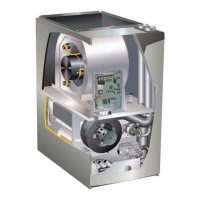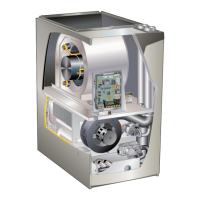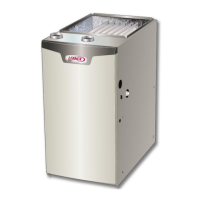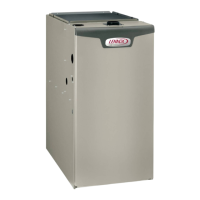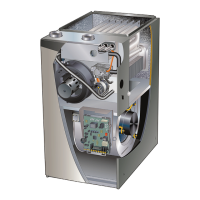Page 50
Other Unit Adjustments
NOTE - See troubleshooting ow charts if any safety
switches are found to be open.
Primary Limit
The primary limit is located on the heating compartment
vestibule panel. This limit is factory set and requires no
adjustment.
Flame Rollout Switches (Two)
These manually reset switches are located on the front of
the burner box.
Pressure Switch
The pressure switch is located in the heating compartment
on the cold end header box. This switch checks for proper
combustion air inducer operation before allowing ignition
trial. The switch is factory-set and must not be adjusted.
Temperature Rise
Place the unit into operation with a second-stage heating
demand. After supply and return air temperatures have
stabilized, check the temperature rise. If necessary, adjust
the heating blower speed to maintain the temperature rise
within the range shown on the unit nameplate. See TABLE
20 on page 59 for allowable heating speeds.Increase
the blower speed to decrease the temperature rise. De-
crease the blower speed to increase the temperature rise.
Failure to properly adjust the temperature rise may cause
erratic limit operation.
Electrical
1 - Check all wiring for loose connections.
2 - Check for the correct voltage at the furnace (furnace
operating). Correct voltage is 120VAC + 10%
3 - Check amp-draw on the blower motor with blower
access panel in place.
Motor Nameplate__________Actual__________
Exhaust and Air Intake Pipe
1 - Check exhaust and air intake connections for
tightness and to make sure there is no blockage.
2 - Is pressure switch closed? Obstructed exhaust pipe
will cause unit to shut o at pressure switch. Check
termination for blockages.
3 - Obstructed pipe or termination may cause rollout
switches to open. Reset manual ame rollout
Heating Sequence of Operation
Electronic Ignition
The two-stage, variable speed integrated control used
in EL296DFE units has an added feature of an internal
Watchguard control. The feature serves as an automatic
reset device for ignition control lockout caused by ignition
failure. After one hour of continuous thermostat demand
for heat, the Watchguard will break and remake thermo-
stat demand to the furnace and automatically reset the
control to begin the ignition sequence.
NOTE - The ignition control thermostat selection DIP
switch is factory-set in the “TWO-STAGE” position.
Applications Using a Two-Stage Thermostat
A - Heating Sequence -- Integrated Control Thermo-
stat Selection DIP Switch 1 OFF in “Two-Stage” Posi-
tion (Factory Setting)
1 - On a call for heat, thermostat rst-stage contacts
close sending a signal to the integrated control. The
integrated control runs a self-diagnostic program
and checks high temperature limit switches for
normally closed contacts and pressure switches for
normally open contacts. The combustion air inducer
is energized at low speed.
2 - Once the control receives a signal that the low
pressure switch has closed, the combustion air
inducer begins a 15-second pre-purge in low speed.
NOTE - If the low re pressure switch does not close
the combustion air inducer will switch to high re.
After a 15 second pre-purge the high re pressure
switch will close and the unit will begin operation on
high re. After 10 to 20 seconds of high re opera-
tion the unit will switch to low re..
3 - After the pre-purge is complete, a 20-second initial
ignitor warm-up period begins. The combustion air
inducer continues to operate at low speed.
4 - After the 20-second warm-up period has ended, the
gas valve is energized on low re (rst stage) and
ignition occurs. At the same time, the control module
sends a signal to begin an indoor blower 30-second
ON-delay. When the delay ends, the indoor blower
motor is energized on the low re heating speed, the
HUM contacts close energizing the humidier and
120V ACC terminal is energized. The furnace will
continue this operation as long as the thermostat has
a rst-stage heating demand.
5 - If second-stage heat is required, the thermostat
second- stage heat contacts close and send a signal
to the integrated control. The integrated control
initiates a 30-second second-stage recognition
delay.
6 - At the end of the recognition delay, the integrated
control energizes the combustion air inducer at high
speed. The control also checks the high re (second
stage) pressure switch to make sure it is closed. The
high re (second stage) gas valve is energized and
the indoor blower motor is energized for operation at
the high re heating speed.
7 - When the demand for high re (second stage) heat
is satised, the combustion air inducer is switched to
the low-re heating speed and the high-re (second
stage) gas valve is de-energized. The low-re (rst
stage) gas valve continues operation. The indoor
blower motor is switched to the low-re heating
speed.
8 - When the thermostat demand for low-re (rst stage)
heat is satised, the gas valve is de-energized and
the eld-selected indoor blower o delay begins.
The combustion air inducer begins a 5-second post-
purge period.
9 - When the combustion air post-purge period is com-
plete, the inducer and the HUM contacts are de-ener-
gized. The indoor blower is de-energized at the end of
the o delay as well as the 120V ACC terminal.

